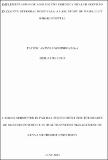| dc.description.abstract | Health service delivery is a key pillar of the health system management .The World Health Organization recently emphasized the need to develop adolescent -friendly health services to improve the care provided to young people throughout the world. However, there is limited peer reviewed literature on this subject therefore necessitating assessment of whether the existing health facilities are prepared to implement the adolescent friendly health services. Adolescent friendly health services remains a relatively new and sensitive area mainly due to restrictive norms and policies guiding the services. After International Conference on Population and Development in 1994, countries started implementing adolescent friendly health services. The Government of Kenya together with partners in an attempt to address the health challenges came up with the Adolescent package of care (APOC) in 2013 whose guidelines were finalized in November 2014 and released for use by service providers. Despite this package of care, there is still ineffective staff capacity in relation to skills and knowledge gap of health professionals, training needs, health resources as well as health system factors that can affect implementation of AFHS. The study explored ways of mitigating or addressing the barriers to implementation of these services. The study used both quantitative and qualitative approaches to collect data. The study utilized survey research adapting descriptive cross sectional design and semi-structured questionnaire to interview 348 health care providers and 472 adolescents in Mam Lucy Kibaki Hospital from 3rd May 2014 to 16 June 2014 .The respondents were mainly nurses, clinical officers and Medical doctors who were working at the health service delivery area at the time of study and were interviewed using an interview guide. The managers at the hospital were interviewed using an in-depth interview guide while the adolescents were interviewed through interview schedule. A total of four (4) focus group discussion was held with adolescents. Quantitative data was analyzed using SPSS Version 18.0. Descriptive statistics and chi-square tests were performed to determine significant associations. The study established that sex, age, level of education and adolescent awareness about existence of friendly health services offered were significantly associated with utilization at p<0.05. Long queues, unfavorable working hours and lack of money negatively affected consumption of AFHS. The study concluded that the utilization of health services among the adolescents was low largely due to unfriendliness of the health care providers at health facilities and lack of awareness of AFHS services. In view of the findings, this study recommends need for the Government through the Ministry of Health and partners in health service provision to increase the number of AFHS and ensure that the recommendations of adolescent package of care is implemented fully with good evaluation strategies in place. Laborious awareness drives to sensitize the adolescents about availability of adolescent friendly services through rigorous health education and increased involvement of both parents/guardians and teachers to scale up implementation are also recommended.
Keywords: Preparedness, Staff Capacity, Health resources and Adolescent friendly Health Services. | en_US |

